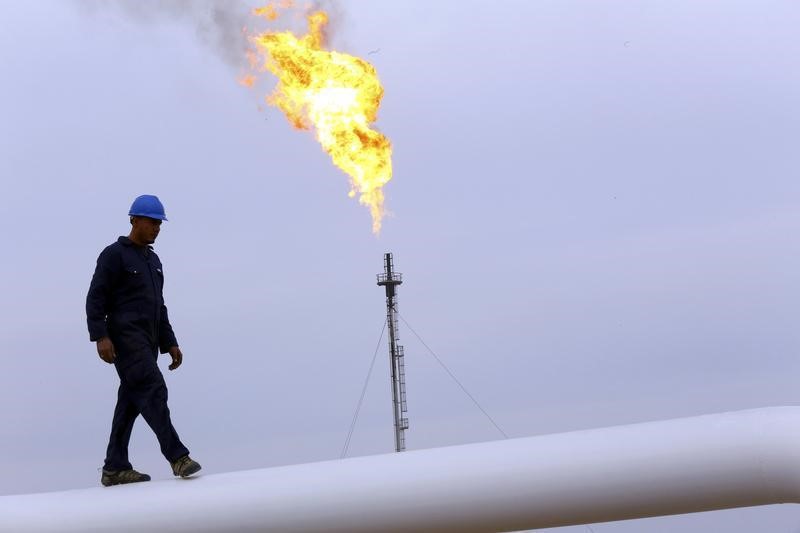Investing.com - Oil prices jumped more than 3% Wednesday, with U.S. crude hitting a 10-month high above $94 a barrel, as traders responded to another weekly drop in crude stockpiles in the United States even as demand for fuels fell amid a seasonal decline in road travel.
New York-traded West Texas Intermediate, or WTI, crude for delivery in November settled at $93.68 per barrel, up $3.29, or 3.7%, on the day. The session peak was $94.14, the highest the crude benchmark had gotten to since November.
London-traded Brent for December delivery settled at $94.36 a barrel, up $1.93, or 2.1%. Brent’s peak for the day was $94.78. The global crude benchmark’s prior high was $95.96 on Sept. 19.
Oil prices have jumped more than 30% over the past three months in response to production squeezes by Saudi Arabia and Russia, though the rally hit a bump last week on economic and demand concerns.
But data on Wednesday from the U.S. government showing crude stockpiles falling a second week in a row reignited the run-up in oil.
The U.S. crude inventory balance fell by 2.169 million barrels during the week ended Sept. 22, according to the Weekly Petroleum Status Report of the U.S. Energy Information Administration, or EIA. Analysts tracked by Investing.com had expected a crude draw of 0.9M barrels instead for last week to add to the 2.135M drop in the prior week to Sept. 15.
Aside from the headline drop in crude stockpiles, the EIA cited a drop of 0.943M barrels last week at the Cushing, Oklahoma hub that serves as a central delivery and storage point for U.S. crude. In the prior week, the API reported a Cushing deficit of 2.064M barrels.
Cushing, Cushing and Cushing
“It’s all about Cushing now, and not without reason, as it’s something that’s making the market very uncomfortable despite the seasonal drop in fuel consumption,” said John Kilduff, partner at New York energy hedge fund Again Capital.
Cushing inventories, already at their lowest since July 2022, are nearing historically low levels after refiners processed more than typical volumes of oil during the just-ended summer. Runaway exports of U.S. crude, particularly for a new grade called WTI Midland — which is comparable to the viscosity of the heavier Arab and Russian oils — have deepened the drain at Cushing. U.S. exports have made inroads into markets underserved by the declines in Saudi and Russian production.
As Cushing inventories continue to fall, analysts said questions are growing about the quality of the remaining oil at the hub and its potential to fall below minimum operating levels.
The situation at Cushing juxtaposes the picture of fuel demand in the United States, which has been on the decline since the summer made way for the autumn, or fall season, that began on Sept. 23.
U.S. fuel demand down though
The EIA reported reported a gasoline inventory gain of 1.027M barrels for last week. The forecast consensus had been for a gasoline draw of 0.5M barrels that would have added to the prior week’s decline of 0.8311M. Automotive fuel gasoline is the No. 1 U.S. fuel product.
With distillate stockpiles, there was a rise of 0.398M barrels versus the expected draw of 1.0M and the prior week’s drop of 2.867M. Distillates are refined into heating oil, diesel for trucks, buses, trains and ships and fuel for jets.
As both WTI and Brent close in on the Saudi target for $100 a barrel, some analysts say economic ructions are likely to show up as energy-driven inflation weighs heavily on global finances.
The eurozone posted abysmal money supply data that showed a record drop in the amount of money in circulation as banks refrained from lending and depositors kept money in savings.
Over in the United States, orders for long-lasting or durable goods rose a stronger-than-expected 0.2% in August, though the increase stemmed from higher defense spending as Washington sought to replenish politically-sensitive military hardware sent to Ukraine.
In a more positive sign, the so-called core orders of durable goods jumped 0.9%. That figure omits defense and transportation and is a proxy for broader business investment.
Two sides to U.S. growth story
But the U.S. growth story isn’t entirely one-way. US consumer spending, already easing on inflation concerns, could witness a sharper slowing in the final three months of the year as labor market and wage growth cool as well, Fitch Ratings said in an economic outlook published Wednesday. It forecast real spending to slow to an annualized rate of 1.2% in 4Q23 and contract by 0.8% in 1Q24 and 3% in 2Q24.
Fitch’s outlook was published a day after The Conference Board, a group that measures US consumer trends, said consumer confidence tumbled for a second month in a row in September, nearing recession levels, as Americans continued to cut spending amid rising inflation.
The Dollar Index got to highs not visited since November 2022. A stronger dollar typically discourages those holding other currencies from buying dollar-denominated commodities, including oil and gold.
Treasury yields, benchmarked to the U.S. 10-year note, shot to fresh 16-year highs on Tuesday, reaching peaks not seen since July 2007.
The two alternatives to gold surged since the Federal Reserve last week projected another quarter-percentage point rate increase by the year-end, despite leaving rates unchanged for September at a policy meeting on Wednesday.
Concerns over the global economy and the overwhelming strength of the dollar could ultimately slow the oil rally again, said those who have been watching both.
"The market is overbought and a correction is definitely needed," Dennis Kissler, senior vice president of trading at BOK Financial, said in comments carried by Reuters.
(Peter Nurse and Ambar Warrick contributed to this item)
